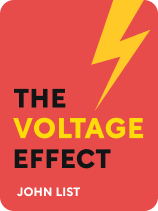

This article is an excerpt from the Shortform book guide to "The Voltage Effect" by John A. List. Shortform has the world's best summaries and analyses of books you should be reading.
Like this article? Sign up for a free trial here.
Is your target audience scalable? How can you make sure that it is?
Just because your initial audience loves your idea, it doesn’t mean that a larger audience will feel the same way. John A. List provides advice on how to understand your target audience initially and as you grow so that you don’t lose momentum over time.
Keep reading to learn how to scale your target audience.
How to Understand Your Target Audience
According to List, individuals and organizations often incorrectly assume that, because an idea is popular with its original audience, it will continue to succeed when scaled to a broader audience. However, if your original audience doesn’t accurately represent the larger audience you hope to scale to, you may find that your idea fizzles out at scale.
For example, a parka salesman living in Alaska would likely find that almost everyone in his local community owns a parka, indicating universal demand for his product. However, if he assumed that his audience in Alaska was representative of an audience in Phoenix, Arizona, and decided to open a second store in Phoenix, he’d probably find that demand for parkas isn’t so universal after all.
List says that, in the interest of long-term growth, it’s vital that you know how to understand your target audience from the start. To determine whether your idea will have an audience at scale, you need to figure out who is in your current audience. The best way to do this is to test your idea in multiple markets that include a wide variety of demographic groups. Testing your idea as broadly as possible will give you the data to determine who your product appeals to, and why.
(Shortform note: Failing to accurately assess the overall audience for your products and services—also known as market need—is a common pitfall for new businesses. It’s estimated that 42% of failed IT startups went under because there wasn’t a significant market need for their products or services. This statistic echoes List’s assertion that overestimating your audience can be fatal for your business.)
Suppose that, to better understand his audience, our parka salesman continues testing his parkas in new markets. To his surprise, focus groups in Toronto and Reykjavik love his parkas, while consumers in Los Angeles and Miami give them the cold shoulder. Based on this data, the parka salesman realizes that parkas only appeal to people who live in cold climates.
(Shortform note: In addition to broadly testing your ideas, you can also use purchase behavior to identify your audience. Often when you advertise products on social media, you’ll be able to generate data on what other goods and services your customers have purchased through that platform’s ads. By using this purchasing data, you can gain a better understanding of who is in your audience and how best to target them. For example, if your company sells protein bars, you might find that your customers also frequently purchased bike parts online. You’d realize that cyclists are a part of your audience, and you’d be able to market to them going forward.)
If your idea appeals only to select groups of people, and you still want to find a way to scale it, you may need to tweak your idea to have a more diverse audience. The key to broadening your audience is figuring out the needs that different groups of people share.
For example, if our parka salesman decides he wants to scale his business to Miami and Los Angeles, he’ll need to diversify his business to have a broader audience. Realizing that he needs to appeal to people who live in warm locations, he could design a line of tank tops and flip-flops to sell instead of parkas in his warm-weather stores.
(Shortform note: Not only will product diversification help your business scale, but it can also help protect your business from unexpected events. When your product is multifaceted and appeals to different groups of people, you’ll be less severely affected by market fluctuations. For example, suppose you have a product that sells well with both teenagers and young adults, and a competitor emerges that proves especially successful with teenagers. Because your product has a wide audience and is still selling well with young adults, this setback will do less damage to your bottom line.)
While having a broad appeal can help to scale your idea, your product doesn’t need to appeal to everyone to be scalable. What’s important is that you understand your audience and only scale your idea to markets where you’re confident it will succeed.
If our parka salesman decides he doesn’t want to tweak his business to work in warm climates, that doesn’t mean his business won’t scale. Instead of adding a flip-flop line, he can simply expand his business to other cold-weather markets, and open stores in Canada, Scandinavia, Siberia, and beyond
(Shortform note: Niche marketing is the marketing industry term for finding ways to sell products with narrow and specific audiences. While businesses that market niche products may be limited by the smaller size of their audience, there are also benefits to niche marketing. Experts note that you’ll usually have fewer competitors in a niche market and that it’s generally easier to market to a narrow niche than to market to more general audiences.)
Caution: False Positives
When determining whether your idea has a big enough audience to scale, remain alert to misleading results. Misleading results, or “false positives,” as List refers to them, are data that overstate the appeal of your idea. List recommends that you replicate your tests to double-check their results, in addition to testing your idea in diverse markets. By replicating tests, you ensure that initial positive results aren’t flukes. If testing indicates that your idea is likely to scale well, you can retest the idea by introducing it in just a few locations before fully scaling up production.
Exercise: Diversify Your Audience
Assess your idea’s current audience and devise strategies to broaden that audience.
- The first red flag that indicates that your idea may not scale is the lack of a scalable audience. The first step in knowing if your audience will scale is identifying your current audience. If your idea has already launched, who has it succeeded with thus far? If your idea has not yet launched, who are you hoping to reach? Briefly describe the group that comprises your current (or target) audience.
- Now that you’ve identified your audience, consider who is not in your audience. Aside from groups that you intentionally aren’t targeting, which groups of people has your product failed to reach thus far? If your idea hasn’t launched yet, which groups are you most concerned about reaching? Below, briefly list one or two of these groups, and describe why you think your product hasn’t yet (or might not) succeeded with them.
- Finally, consider how you might diversify your idea to broaden your audience. For each group you listed in the previous prompt, consider how you might alter your idea to make it more attractive to that group. For example, if your organization sells chew toys for dogs, and you want to start marketing your products to cat owners, you could begin by designing a new line of laser pointers or other cat toys. Below, list one or two ways you can tweak your idea to make it more scalable.

———End of Preview———
Like what you just read? Read the rest of the world's best book summary and analysis of John A. List's "The Voltage Effect" at Shortform.
Here's what you'll find in our full The Voltage Effect summary:
- How to take ideas from the small scale to the big stage
- The red flags that signal you may have trouble scaling up
- Strategies designed to increase your idea’s chances of success






